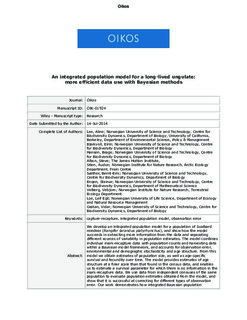| dc.contributor.author | Lee, Aline Magdalena | |
| dc.contributor.author | Bjørkvoll, Eirin Marie | |
| dc.contributor.author | Hansen, Brage Bremset | |
| dc.contributor.author | Albon, Steve D. | |
| dc.contributor.author | Stien, Audun | |
| dc.contributor.author | Sæther, Bernt-Erik | |
| dc.contributor.author | Engen, Steinar | |
| dc.contributor.author | Veiberg, Vebjørn | |
| dc.contributor.author | Loe, Leif Egil | |
| dc.contributor.author | Grøtan, Vidar | |
| dc.date.accessioned | 2018-12-14T11:51:46Z | |
| dc.date.available | 2018-12-14T11:51:46Z | |
| dc.date.created | 2015-03-05T12:19:30Z | |
| dc.date.issued | 2015 | |
| dc.identifier.citation | Oikos. 2015, 124 (6), 806-816. | nb_NO |
| dc.identifier.issn | 0030-1299 | |
| dc.identifier.uri | http://hdl.handle.net/11250/2577731 | |
| dc.description.abstract | We develop an integrated population model for Svalbard reindeer Rangifer tarandus platyrhynchus, and demonstrate how this type of model can be used to extract more information from the data and separate different sources of variability in population estimates. Our model combines individual mark–recapture data with population counts and harvesting data within a Bayesian model framework, and accounts for observation error, environmental and demographic stochasticity,and age structure. From this model we obtain annual estimates of age-specific population size, survival and fecundity. The model provides estimates of age structure at a finer scale than that found in the census data, and enables us to estimate survival for the period before calves are first caught and marked, i.e. before they enter the individual mark–recapture data. The modeling framework provides an improved approach to studying age-structured populations that are imperfectly censused and where the demography of only a sample of individuals is known. We use data from independent censuses of the same population to evaluate population estimates obtained from the model, and show that it is successful at correcting for different types of observation error. Based on our model results, we suggest that allocating resources to the collection of supplementary mark–recapture data could improve the reliability of population projections more than making regular population censuses as exhaustive as possible. Our work demonstrates how integrated Bayesian population modeling can be used to increase the amount of information extracted from collections of data, identifying and disentangling sources of variation in individual performance and population size. This represents an important step towards increasing the predictive ability of population growth models for long-lived species experiencing changes in environmental conditions and harvesting regimes. | |
| dc.language.iso | eng | nb_NO |
| dc.rights | Attribution-NonCommercial-NoDerivatives 4.0 Internasjonal | * |
| dc.rights.uri | http://creativecommons.org/licenses/by-nc-nd/4.0/deed.no | * |
| dc.title | An integrated population model for a long-lived ungulate: more efficient data use with Bayesian methods | nb_NO |
| dc.type | Journal article | nb_NO |
| dc.type | Peer reviewed | nb_NO |
| dc.description.version | submittedVersion | |
| dc.source.pagenumber | 806-816 | nb_NO |
| dc.source.volume | 124 | nb_NO |
| dc.source.journal | Oikos | nb_NO |
| dc.source.issue | 6 | nb_NO |
| dc.identifier.doi | 10.1111/oik.01924 | |
| dc.identifier.cristin | 1229647 | |
| dc.relation.project | Norges forskningsråd: 223257 | nb_NO |
| dc.relation.project | EU/268562 | nb_NO |
| dc.relation.project | Norges forskningsråd: 178561 | nb_NO |
| cristin.unitcode | 192,14,0,0 | |
| cristin.unitname | Miljøvitenskap og naturforvaltning | |
| cristin.ispublished | true | |
| cristin.fulltext | preprint | |
| cristin.qualitycode | 1 | |

